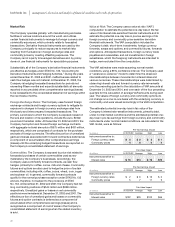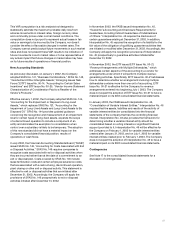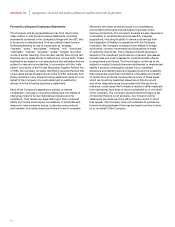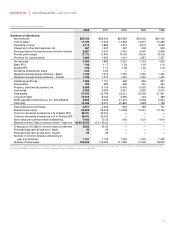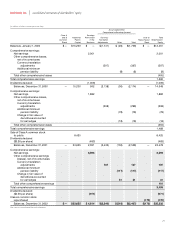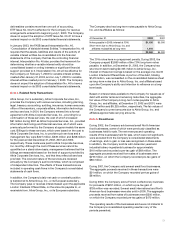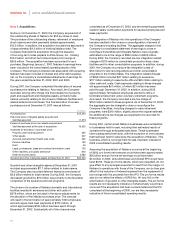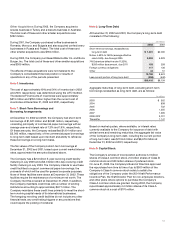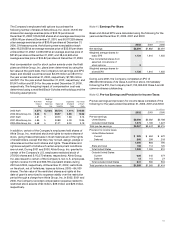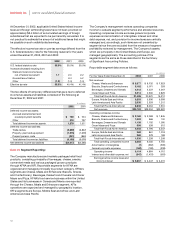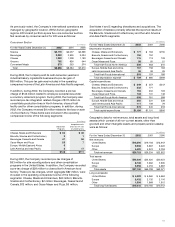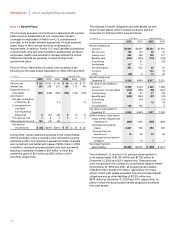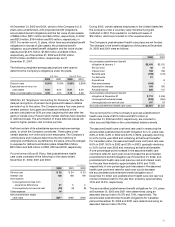Kraft 2002 Annual Report Download - page 53
Download and view the complete annual report
Please find page 53 of the 2002 Kraft annual report below. You can navigate through the pages in the report by either clicking on the pages listed below, or by using the keyword search tool below to find specific information within the annual report.
Intangible assets as of December 31, 2002 were as follows:
(in millions)
Gross
Carrying Accumulated
Amount Amortization
Non-amortizable intangible assets $11,485
Amortizable intangible assets 54 $30
Total intangible assets $11,539 $30
Non-amortizable intangible assets are substantially comprised
of brand names purchased through the Nabisco acquisition.
Amortizable intangible assets consist primarily of certain
trademark licenses and non-compete agreements. Pre-tax
amortization expense for intangible assets was $7 million for
the year ended December 31, 2002. Based upon the amortizable
intangible assets recorded on the consolidated balance sheet at
December 31, 2002, amortization expense for each of the next
five years is estimated to be $8 million or less.
The increase in goodwill and other intangible assets, net,
during the year ended December 31, 2002, of $463 million is
primarily related to currency translation, partially offset by a
$76 million decrease in goodwill relating to the favorable
completion of severance and exit programs associated
with the Nabisco acquisition.
Environmental costs: The Company is subject to laws and
regulations relating to the protection of the environment. The
Company provides for expenses associated with environmental
remediation obligations on an undiscounted basis when such
amounts are probable and can be reasonably estimated.
Such accruals are adjusted as new information develops or
circumstances change.
While it is not possible to quantify with certainty the potential
impact of actions regarding environmental remediation and
compliance efforts that the Company may undertake in the
future, in the opinion of management, environmental remediation
and compliance costs, before taking into account any recoveries
from third parties, will not have a material adverse effect on the
Company’s consolidated financial position, results of operations
or cash flows.
Foreign currency translation: The Company translates the
results of operations of its foreign subsidiaries using average
exchange rates during each period, whereas balance sheet
accounts are translated using exchange rates at the end of each
period. Currency translation adjustments are recorded as a
component of shareholders’ equity. Transaction gains and losses
are recorded in the consolidated statements of earnings and were
not significant for any of the periods presented.
Guarantees: In November 2002, the Financial Accounting
Standards Board (“FASB”) issued Interpretation No. 45,
“Guarantor’s Accounting and Disclosure Requirements for
Guarantees, Including Indirect Guarantees of Indebtedness
of Others.” Interpretation No. 45 requires the disclosure of
certain guarantees existing at December 31, 2002. In addition,
Interpretation No. 45 requires the recognition of a liability for the
fair value of the obligation of qualifying guarantee activities that
are initiated or modified after December 31, 2002. Accordingly,
the Company will apply the recognition provisions of Interpretation
No. 45 prospectively to guarantee activities initiated after
December 31, 2002. See Note 17. Contingencies for a further
discussion of guarantees.
Hedging instruments: Effective January 1, 2001, the Company
adopted SFAS No. 133, “Accounting for Derivative Instruments
and Hedging Activities,” and its related amendment, SFAS No.
138, “Accounting for Certain Derivative Instruments and Certain
Hedging Activities” (collectively referred to as “SFAS No. 133”).
These standards require that all derivative financial instruments
be recorded on the consolidated balance sheets at their fair
value as either assets or liabilities. Changes in the fair value
of derivatives are recorded each period either in accumulated
other comprehensive losses or in earnings, depending on
whether a derivative is designated and effective as part of a
hedge transaction and, if it is, the type of hedge transaction.
Gains and losses on derivative instruments reported in
accumulated other comprehensive earnings (losses) are
reclassified to the consolidated statement of earnings in the
periods in which operating results are affected by the hedged
item. Cash flow hedging instruments are classified in the same
manner as the affected hedged item in the consolidated
statements of cash flows. As of January 1, 2001, the adoption
of these new standards did not have a material effect on net
earnings (less than $1 million) or accumulated other
comprehensive losses (less than $1 million).
Impairment of long-lived assets: The Company reviews
long-lived assets, including amortizable intangible assets,
for impairment whenever events or changes in business
circumstances indicate that the carrying amount of the
assets may not be fully recoverable. The Company performs
undiscounted operating cash flow analyses to determine if an
impairment exists. If an impairment is determined to exist,
any related impairment loss is calculated based on fair value.
Impairment losses on assets to be disposed of, if any, are based
on the estimated proceeds to be received, less costs of disposal.
Effective January 1, 2002, the Company adopted SFAS No. 144,
“Accounting for the Impairment or Disposal of Long-Lived
Assets,” which replaces SFAS No. 121, “Accounting for the
Impairment of Long-Lived Assets and Long-Lived Assets to
Be Disposed Of.” SFAS No. 144 provides updated guidance
concerning the recognition and measurement of an impairment
loss for certain types of long-lived assets, expands the scope
of a discontinued operation to include a component of an entity
and eliminates the exemption to consolidation when control
over a subsidiary is likely to be temporary. The adoption of
this new standard did not have a material impact on the
Company’s consolidated financial position, results of operations
or cash flows.
49



